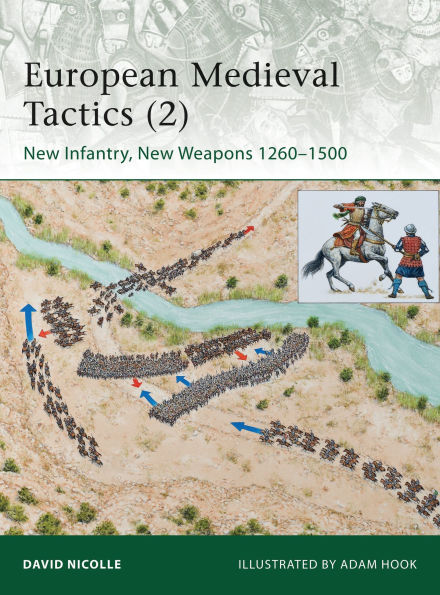European Medieval Tactics (2): New Infantry, New Weapons 1260-1500
With the development in the 13th century of co-operative tactics using crossbowmen and heavy spearmen, the charge by Muslim horse-archers, and then by European armoured knights, could be defied.
Infantry were far cheaper and easier to train than knights, and potentially there were far more of them. Tactics emerged by which more numerous and more varied infantry played an increasing part in battles.
This book traces these and other examples of this 'jerky' and uneven process through its regional differences, which were invariably entwined with parallel cavalry developments – the balanced army of 'mixed arms' was always the key to success. By the time serious hand-held firearms appeared on battlefields in large numbers in about 1500, the face of medieval warfare had been transformed.
This lavishly illustrated guide investigates the reappearance of massed, disciplined infantry, and assesses the challenge they posed to the mounted knights who had dominated the battlefield in the early Middle Ages.
1115833471
Infantry were far cheaper and easier to train than knights, and potentially there were far more of them. Tactics emerged by which more numerous and more varied infantry played an increasing part in battles.
This book traces these and other examples of this 'jerky' and uneven process through its regional differences, which were invariably entwined with parallel cavalry developments – the balanced army of 'mixed arms' was always the key to success. By the time serious hand-held firearms appeared on battlefields in large numbers in about 1500, the face of medieval warfare had been transformed.
This lavishly illustrated guide investigates the reappearance of massed, disciplined infantry, and assesses the challenge they posed to the mounted knights who had dominated the battlefield in the early Middle Ages.
European Medieval Tactics (2): New Infantry, New Weapons 1260-1500
With the development in the 13th century of co-operative tactics using crossbowmen and heavy spearmen, the charge by Muslim horse-archers, and then by European armoured knights, could be defied.
Infantry were far cheaper and easier to train than knights, and potentially there were far more of them. Tactics emerged by which more numerous and more varied infantry played an increasing part in battles.
This book traces these and other examples of this 'jerky' and uneven process through its regional differences, which were invariably entwined with parallel cavalry developments – the balanced army of 'mixed arms' was always the key to success. By the time serious hand-held firearms appeared on battlefields in large numbers in about 1500, the face of medieval warfare had been transformed.
This lavishly illustrated guide investigates the reappearance of massed, disciplined infantry, and assesses the challenge they posed to the mounted knights who had dominated the battlefield in the early Middle Ages.
Infantry were far cheaper and easier to train than knights, and potentially there were far more of them. Tactics emerged by which more numerous and more varied infantry played an increasing part in battles.
This book traces these and other examples of this 'jerky' and uneven process through its regional differences, which were invariably entwined with parallel cavalry developments – the balanced army of 'mixed arms' was always the key to success. By the time serious hand-held firearms appeared on battlefields in large numbers in about 1500, the face of medieval warfare had been transformed.
This lavishly illustrated guide investigates the reappearance of massed, disciplined infantry, and assesses the challenge they posed to the mounted knights who had dominated the battlefield in the early Middle Ages.
16.8
In Stock
5
1

European Medieval Tactics (2): New Infantry, New Weapons 1260-1500
64
European Medieval Tactics (2): New Infantry, New Weapons 1260-1500
64
16.8
In Stock

Product Details
| ISBN-13: | 9781780968841 |
|---|---|
| Publisher: | Bloomsbury Publishing |
| Publication date: | 08/20/2012 |
| Series: | Elite , #189 |
| Sold by: | Barnes & Noble |
| Format: | eBook |
| Pages: | 64 |
| File size: | 10 MB |
About the Author
What People are Saying About This
From the B&N Reads Blog
